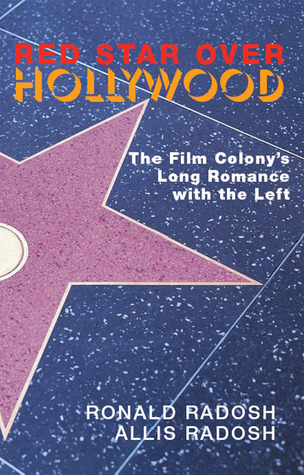This new consideration of a well-worn subject is altogether justified for two salient reasons. The first is that Red Star Over Hollywood contains new material and judgment fortified by new research and information; the second, that the topic has been distorted not only by failures of interpretation but by continuing exploitation, even today. The Radoshes are quite clear on this second point: Hollywood continues to broadcast much mythology about the communists in Lala Land, the HUAC hearings, and all the rest of it. Though the emphasis here is on the 30’s, 40’s, and early 50’s, the subsequent justification, victimology, and mendacity are remarkable in themselves, as contemporary bad movies have something to say about the nature of movies as well as about political-historical amnesia and manipulation.
The Way We Were (1973) rather misses the point of its own story, but don’t try telling that to Barbra Streisand. The Front (1976) is not a Woody Allen movie but a movie starring Woody Allen, the comedy of which fails to mesh with its mawkish revisionism. Marathon Man (1976) mixes political mythology with melodrama in such an annoying way as to suggest a new interpretation of the torture scene. In this film, the CIA protects Nazis, and the protagonist’s father was a victim of the blacklist. The House on Carroll Street (1987) has so much retro charm as a Hitchcock pastiche that you might not notice the political suggestion: Anticommunism equals pro-Fascism. Fellow Traveller (1989) wallows in the tragedy of the blacklist, as does Guilty by Suspicion (1991). The Majestic (2001) is the same old fantasy, and an odd Jim Carrey vehicle. One of the Hollywood Ten (2002), about Herbert Biberman and the making of Salt of the Earth, contains gross distortions of fact and nuance. And so it goes, as if we knew nothing about the history of the Communist Party in America and in Hollywood. Maybe nothing is what we are supposed to know—or not to know.
To remind us of the way we actually were, to repair some of the damage broadcast by Hollywood and institutionalized by the Academy, and to take advantage of the Venona files and other new information, Ronald and Allis Radosh have recreated the grounded meaning of Hollywood’s infatuation with left-wing politics. One of their strongest points is to insist on the specific meaning of Stalinism; another is to emphasize Moscow’s control of the American Communist Party.
Hollywood was targeted by the Comintern from early on and penetrated by agents answering directly to Moscow—including Otto Katz, who, in one of his identities, was involved with Lillian Hellman. Later on, when Katz was tortured and murdered during the Slansky episode in the Czechoslovakia of 1952, his old Stalinist friends in Hollywood knew he was innocent but kept mum—party discipline, you know.
But the penetration of Hollywood by international agents was matched by the conversion of film-industry types to communism, often in connection with a visit to the Soviet Union. Joseph Losey, Jay Leyda, Budd Schulberg, and Maurice Rapf are famous examples. John Howard Lawson and Lester Cole were Stalinists who became part of the “Hollywood Ten” only after years of service to the party in Hollywood. As the faithful danced to the tune that was called, however, a rather disconcerting hitch known as the Nazi-Soviet pact was signed. The political and intellectual contortions that followed this reversal of policy, which revealed the power of the party as well as its profound corruption, was a blow from which the alliance of liberals and communists never recovered. There would still be time, however, to contribute to a “war effort” that included making nice with Uncle Joe Stalin.
The Radoshes’ account of a seldom-seen film, Mission to Moscow (1943), explains a lot of context that has been forgotten. Based on Amb. Joseph Davies’ memoir of the same name (1941), the film is unadulterated Stalinist propaganda—basically a justification of the notorious purges of 1936-8. In an exquisite moment, the Radoshes point out that Jack Warner himself, in testifying to the HUAC, actually employed Stalinist logic, dismissing the criticisms of John Dewey as “Trotskyite.” Davies had insisted that the film deny that the Soviet Union had invaded Finland in 1939, and so it did. Such extremity was denounced even by such leftists as James Agee, Edmund Wilson, and Dwight Macdonald. The crop that the Hollywood left was to reap was the one they had sown.
Another vital point registered by the Radoshes has to do with an article published in a French communist journal in April 1945 and signed by Jacques Duclos. Written in Moscow and approved by Stalin, it rejected cooperation with the West. The former head of the Communist Party in America, Earl Browder himself, later called the piece “the first public declaration of the Cold War.” Similarly, in their account of the clash between the communists and HUAC, the authors make a new and authentic point in publishing a letter from John Garfield to Dore Schary dated October 13, 1950, in which that “victim” declared he was against communist policy and wanted to appear in anticommunist films. They suggest a revision of the received image of Garfield as a victim of the blacklist to that of a victim of the Communist Party.
Supplying useful perspectives on much disputed history, Ronald and Allis Radosh have given us an indispensable book that tells us what we need to know about such people as Elia Kazan and Victor Navasky. The resulting clarity allows us to begin to understand the power and ambiguity of film and the attraction it exerts over the public—and over those who would deceive the public.
[Red Star Over Hollywood: The Film Colony’s Long Romance With the Left, by Ronald Radosh and Allis Radosh (San Francisco: Encounter Books) 309 pp., $25.95]

Leave a Reply